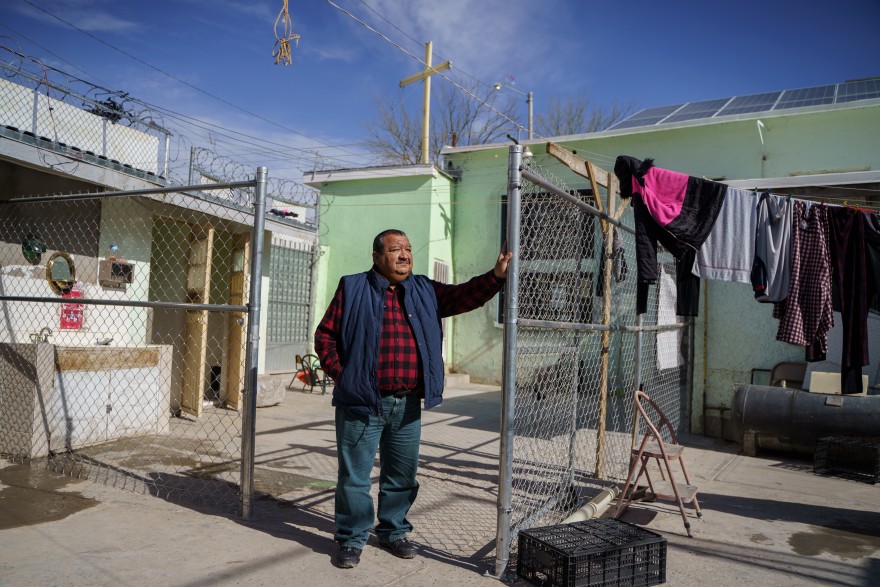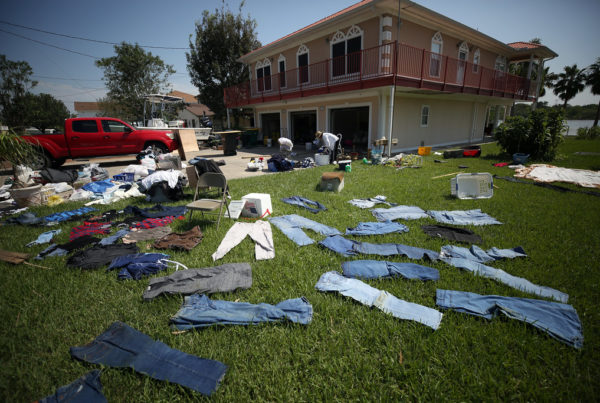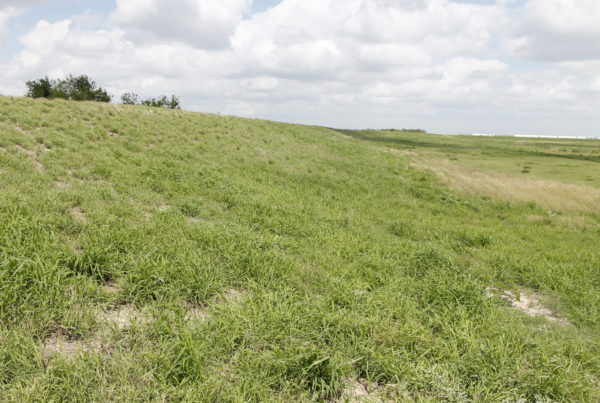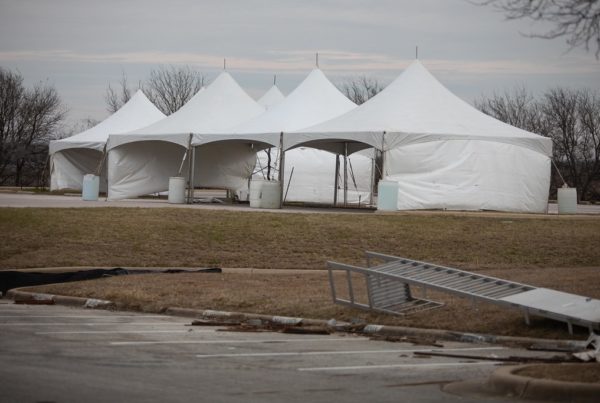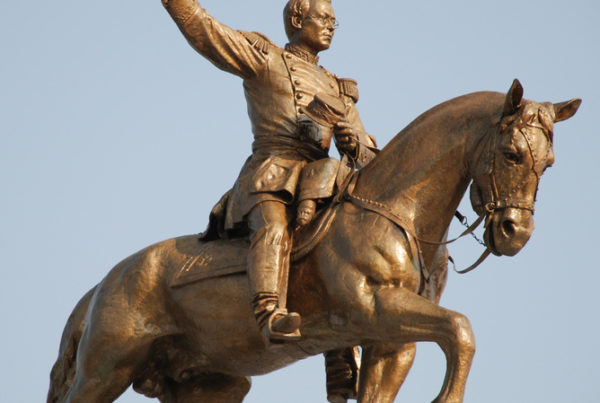From KERA:
The Pan de Vida migrant shelter sits on the outskirts of Ciudad Juárez, just a few miles across the border from El Paso. It’s made up of several small houses, encircling a dusty courtyard.
One larger building has been turned into a makeshift quarantine space. Blue sleeping pads line the floor. On a windy afternoon, a few children kicked a ball back and forth, trying to avoid napping families. Several migrant women chopped vegetables in the group kitchen, making chicken soup for those who just arrived.
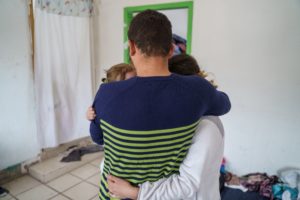
Jiuver, his pictured with his wife and daughter at the Pan de Vida Migrant Shelter in Ciudad Juárez, Chihuahua, Mexico in March. They, along with many others in the shelter, had recently been expelled to Juárez via flights from the Rio Grande Valley.
Paul Ratje for KERA News
A Honduran father named Jiuver cradled his infant daughter, stroking the wisps of her soft brown hair. He was still trying to understand what happened — how he ended up at this shelter, nearly 800 miles from where he first crossed the border in South Texas.
“They didn’t tell us anything,” he said of U.S. immigration officials. “They simply threw us out.”
Jiuver asked KERA not to use his full name, because of his uncertain immigration status.
Just over 100 days into Joe Biden’s presidency, the U.S.-Mexico border remains closed to most migrants and asylum seekers under a public health order issued at the start of the pandemic.
That order, known as Title 42, allows officials to quickly expel migrants who cross the border, and turn away asylum seekers at ports of entry.
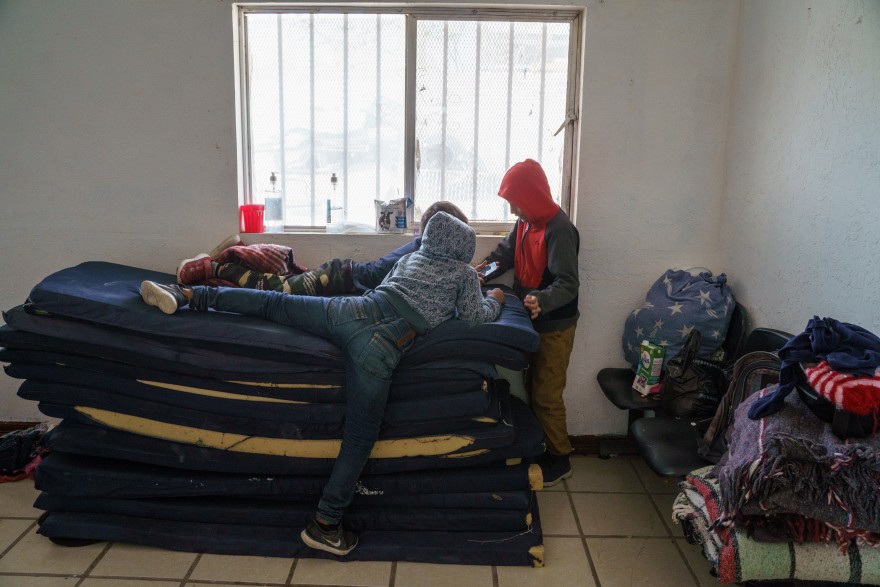
Boys are pictured at the Pan de Vida Migrant Shelter in Ciudad Juárez Chihuahua, Mexico in March.
Along the border in the Rio Grande Valley, Mexico stopped taking back families with very young children earlier this year. Some of those families are now being released into the U.S. to pursue asylum. But since March, the U.S. government has been flying others to different border cities, including El Paso and San Diego, before expelling them back into Mexico.
Jiuver said he, his wife and daughter spent several days in U.S. custody after crossing the border between Reynosa and McAllen. When officials woke them up early one morning, he thought they were being taken to family in the U.S.
Instead, they were put on a plane, flown to El Paso, then walked to the middle of an international bridge.
“We never imagined it,” he said, still stunned that they were returned to Mexico.
Many families like Jiuver’s have ended up at shelters like Pan de Vida, which scrambled to ensure parents and children weren’t left on the street.
Ismael Martinez, director of Pan de Vida, said the space can currently hold around 300 people. Like at other local shelters, capacity is limited because of COVID-19 precautions, but he has done his best to take people in.
Some of the shelter’s long-term residents are slowly entering the U.S. as the government unwinds a different Trump-era policy, the Migrant Protection Protocols, which required asylum seekers to wait in Mexico for their U.S. court dates.
“People are leaving for the United States, and they’re creating space for new people,” Martinez said.

A boy looks at a smartphone at the Pan de Vida Migrant Shelter in Ciudad Juárez, Chihuahua, Mexico in March.
Still, more migrants arrive each day than Juarez’s existing shelters, many of them church-run, can take in. The city recently opened a new shelter in a gym to accommodate more families.
“At least a hundred people are returned to Juárez daily,” through expulsion flights from South Texas, according to Rogelio Pinal Castallenas, the city’s human rights director. That’s in addition to migrants who attempt to cross the El Paso-Juárez border and are quickly turned back under Title 42.
“It’s because of this situation that the country is left with this challenge of giving people a safe place to stay,” Pinal said.
Pinal oversees the new shelter at the municipal gym. He said some children arrive in need of medical care; many become sick in freezing border patrol facilities, known as hieleras or ice boxes.
“Mexico again is taking the brunt of our failures,” said Linda Rivas, executive director of Las Americas Immigrant Advocacy Center in El Paso.
She noted that families are held in close quarters in border processing centers, placed on planes and flown from one border city to another, then expelled into Juárez, all without being tested for COVID-19.
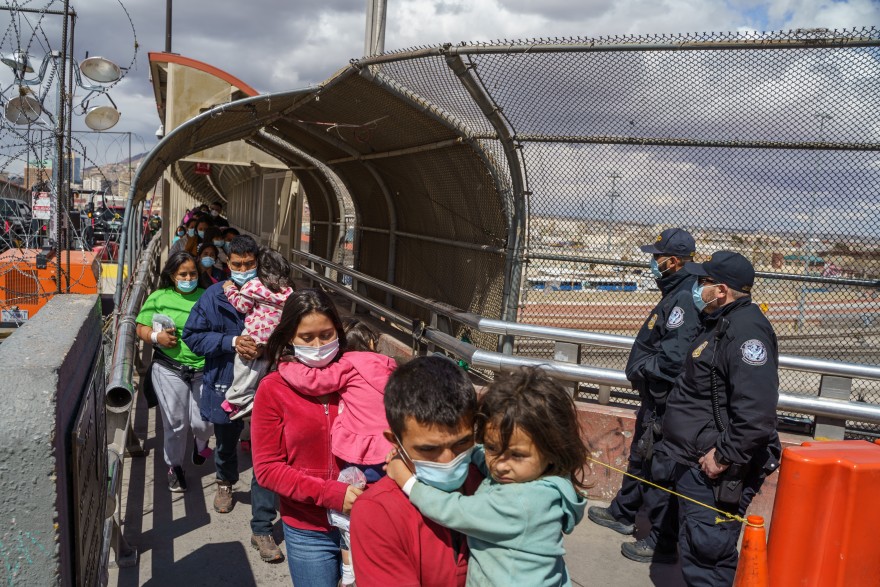
Families that crossed the border in the Rio Grande Valley are expelled to Mexico after arriving to El Paso on a flight from Brownsville, Texas in Ciudad Juárez Chihuahua, Mexico in March.
“I think we have a huge problem with these flights,” she said. “We have a huge problem with how we’re responding to peoples’ need to migrate.”
Across town from Pan de Vida, on a drizzly morning a few weeks ago, pastor Juan Fierro pointed out the makeshift quarantine space at his shelter, El Buen Samaritano: A separate room filled with bunk beds and cordoned off by wooden benches.
At that time, El Buen Samaritano was crowded and Fierro was stretched thin taking in expelled families, mostly mothers with children between one and eight years old.
Now, the new city-run shelter in the gym has relieved some of the pressure on Fierro, creating some breathing room and open space at El Buen Samaritano.
But during that initial busy period, it was hard for Fierro to counsel families, because there is no clear guidance on if and when Title 42 will be lifted.
“We don’t have a timeline so as to tell the migrants, ‘You know what? You have to wait here a month. You know what? Two months. Three months,’” he said. He still doesn’t know exactly when people will be able to ask for asylum again.
That uncertainty led to a sort of revolving door at the shelter, Fierro said. While some families finished their quarantine and chose to stay at the shelter, others left soon after they arrived.
Sitting at his desk, Fierro pulled out a stack of basic health charts for each new resident, where he tracked their temperatures and daily conditions — whether they had chest pains or sore throats — and noted just how many people had moved on.
“They already left,” he said, flipping through the charts. “They already left.”
Fierro suspected some left to try their luck crossing the border again, hoping their second or third time across would be successful.
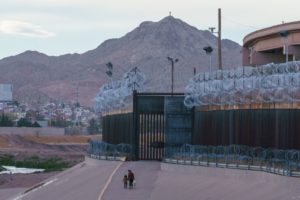
A woman and child look for an entry point on the U.S.-Mexico border fence between El Paso, Texas and Ciudad Juárez, Mexico seen from Ciudad Juárez, Chihuahua, Mexico in March.
It’s hard to know how many expelled migrants are currently staying in Juárez.
“It’s an unknown number,” Rogelio Pinal said. “It would be irresponsible to give you an estimate.”
He said some request to go back to their home countries, and many turn to smugglers to facilitate another border crossing.
“We don’t really know where they end up, if they’re still in Juárez or not,” Pinal said.
“If a person wants to come to the United States right now, the only chance they have is to maybe go through Reynosa and be one of the lucky ones that doesn’t get expelled,” said Linda Rivas. “That’s not an asylum system.”
Some have left, but others plan to wait things out in Juárez, hoping a policy change gives them back something they’re legally entitled to: The chance to request asylum.
Mallory Falk is a corps member with Report For America, a national service program that places journalists into local newsrooms. Got a tip? Email Mallory at Mfalk@kera.org. You can follow Mallory on Twitter @MalloryFalk.


